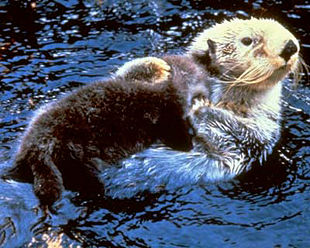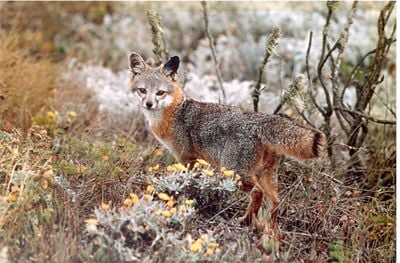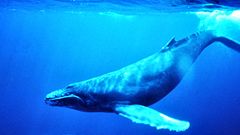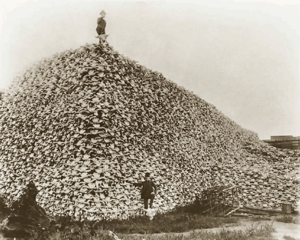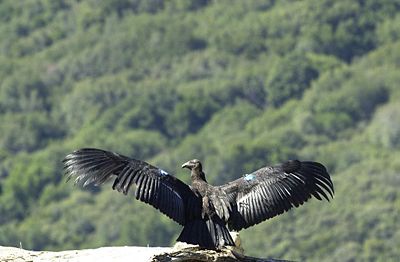Endangered species
An endangered species is any animal or plant species that is in danger of extinction throughout all or a significant portion of its range and/or whose habitat has been drastically reduced such that the species is deemed in danger of extinction. The term has also been extended to other taxa, particularly subspecies (endangered subspecies).
The expression endangered species is also used for anything or anyone that is in danger of dying out, such as "conservatives are an endangered species in this area."
Many of the causes of species decline relate to the activities of human beings. Laws to protect endangered species and their habitats thus place restrictions on human activities and are sometimes controversial. For example, to protect endangered species of fish, water from a stream may be withheld from farmers during a drought, protecting the fish but causing farmers to lose crops. As stewards of creation, human beings have a responsibility to care for all creatures. Human beings seek to find a balance between the care for endangered species and the needs of human communities. In doing so, it is important to involve all valuesâaesthetic, moral, recreational, scientific, and religiousânot just economic values, and to not allow short-term or self-centered economic goals, or individual goals, to dominate long-term environmental sustainability or the needs of the community at large.
Overview
Many countries have laws offering special protection to endangered species or their habitats: for example, forbidding hunting, restricting land development, or creating preserves. Only a few of the many endangered species actually make it to the lists and obtain legal protection. Many more species become extinct, or potentially will become extinct, without gaining public notice.
The ICUN (the World Conservation Union) is the group that governments, scientists, academics, and conservation groups look to for designation of a species as endangered.
The ICUN states that a species is critically endangered when it meets any of the following criteria:
- Its population has been reduced by 90 percent in the last ten years.
- Its population has been reduced over 80 percent in the last ten years, where the cause of reduction has not been stopped or is determined to be irreversible.
- Its population is expected to be reduced by 80 percent in the next ten years or three generations, whichever is longer, up to a maximum of 100 years.
- Its population size is estimated to be 250 mature species or less.
The ICUN states that a species is considered endangered when the species meets any of the following criteria.
- Its population has been reduced by 70 percent in the last ten years.
- It population has been reduced over 50 percent in the last ten years, where the cause of reduction has not been stopped or is determined to be irreversible.
- Its population is suspected to be reduced by 50 percent in the next ten years or three generations, whichever is longer, up to a maximum of 100 years.
- The species is known to exist in five or less geographic locations.
Some of the more well known endangered species include the giant panda, some whales and dolphins, rhinoceroses, elephants, marine turtles, and the great apes.
Other endangered species may not be as well known to the general public, but may play as equal or even greater role to the preservation and integrity of ecosystems.
Some endangered species laws are controversial. Typical areas of controversy include: criteria for placing a species on the endangered species list, and criteria for removing a species from the list once its population has recovered; whether restrictions on land development constitute a "taking" of land by the government; the related question of whether private landowners should be compensated for the loss of use of their land; and obtaining reasonable exceptions to protection laws.
Sometimes conservation policies call for the re-introduction of an endangered species to an ecosystem, such as the repopulating of Yellowstone Park with gray wolves (Canis lupus), brought from Canada in 1995. However, such re-introductions are an art science, rather than an exact science, since there are too many variables to be sure what is going to happen. History is replete with examples of good intentions having undesirable consequences, such as efforts to manage the Everglades leading to catastrophic exaggerations of the flood-and-drought cycle, or the elimination of DDT, exacerbating the problem with malaria in Africa. Thus, humanity has to have the humility to recognize an uncertainty in knowing what will happen when conservation policy involves changing nature or working with a complex ecosystem.
Being listed as an endangered species can backfire, since it could make a species more desirable for collectors and poachers [1]. However, this is usually considered a spurious argument by those favoring loose protection laws.
Causes of species decline
Species may become endangered for several reasons, including introduction of new predators and competitors, disease, overhunting and international trade, environmental change, and development practices.
For thousands of years, humans have been transporting animals and plants from one location to another, whether deliberately (livestock) or accidentally (rats). Such introduced species can have catastrophic impacts on endemic (native) species. Sometimes pathogens or parasites are introduced as well.
Overhunting has often caused significant species decline, such as the taking of millions of caimans in the Pantanal for their commercial uses, or overfishing of whales. It is estimated that the worldâs tiger and rhino species could be extinct within just a few years if international trade in their parts is not eliminated or significantly regulated.
Climate change has been an historical cause of extinctions, such as ice ages and other factors involved in mass extinctions. Present climate change may also be a significant factor, such as long, severe droughts causing species to become endangered. Some scientists predict that current climate change trends will perhaps be far more devastating to many of the worldâs species than other causes.
Development practices that continue to reduce habitat is another ongoing reason species become endangered or extinct. Over 50 percent of the Florida Everglades has been lost since the 1950s, largely due to conversion to intensive residential or agricultural purposes. Every time an acre of rainforest is chopped or burned down, we might be losing a plant that can provide medical value, such as a cure for cancer or AIDS. Some researchers claim this has already happened when they found that the bark of a gum tree in Malaysia showed promise in killing the AIDS virus. When they returned to Malaysia for more samples the tree was gone, chopped down, and no more species have since been found.
The greatest factor of concern is the rate at which species are becoming extinct within the last 150 years, sometimes considered part of a mass extinction event called the Sixth Extinction. While species have evolved and become extinct on a regular basis for the last several hundred million years, the number of species becoming extinct since the Industrial Revolution has no precedent in biological history. If this rate of extinction continues, or accelerates as now seems to be the case, the number of species becoming extinct in the next century could number in the tens of thousands. While most people readily relate to endangerment of large mammals or birdlife, some of the greatest ecological issues are the threats to stability of whole ecosystems if key species vanish at any level of the food chain.
Issues of extinction
Species extinction is the obvious ultimate concern for a species considered endangered. There are four reasons to have concern with this outcome: (a) Loss of a species as a biological entity, (b) Destabilization of an ecosystem, (c) Endangerment of other species, and (d) Loss of irreplaceable genetic material and associated biochemicals.
The loss of a species in and of itself is an important factor, both as diminution of the enjoyment of nature and as a moral issue for those who believe humans are stewards of the natural environment. Destabilization is a well understood outcome as well, when an element of food or predation is removed from an ecosystem. Examples abound that other species are in turn affected, such that population increases or declines are forthcoming in these secondary species. Remove a predator and a prey species may overrun the ecosystem. Drastic change or an unstable spiral can ensue, until other species are lost and the ecosystem structure is changed markedly and irreversibly.
The fourth outcome is more subtle, but perhaps the most important point for humanity to grasp. Each species carries unique genetic material in its DNA and in its chemical factory responding to these genetic instructions. For example, in the valleys of central China, a fernlike weed called sweet wormwood grows, that is the only source of artemisinin, a drug that is nearly 100 percent effective against malaria (Jonietz 2006). If this plant were lost to extinction, then the ability to control malaria, even today a potent killer, would diminish. There are countless other examples of chemicals unique to a certain species, whose only source is the species, whose genetic factory makes that given substance. How many further chemicals have not yet been discovered and could vanish from the planet when further species become extinct?
Conservation status
The conservation status of a species is an indicator of the likelihood of that endangered species continuing to survive. Many factors are taken into account when assessing the conservation status of a species; not simply the number remaining, but the overall increase or decrease in the population over time, breeding success rates, known threats, and so on.
The best-known worldwide conservation status listing is the IUCN Red List, but many more specialized lists exist.
The following conservation status categories are used. They are loosely based on the IUCN categories.
- Extinct: the last remaining member of the species had died, or is presumed to have died beyond reasonable doubt. Examples: Thylacine, Dodo.
- Functionally extinct: a handful of individuals are surviving, but are unable to reproduce due to health, age, lack of both sexes (in species that reproduce sexually), or other reasons.
- Extinct in the wild: captive individuals survive, but there is no free-living, natural population. Examples: Dromedary, Przewalski's Horse.
- Critical or critically endangered: faces an extremely high risk of extinction in the immediate future. Examples: Ivory-billed Woodpecker, Arakan Forest Turtle
- Endangered: faces a very high risk of extinction in the near future. Examples: Blue whale, Kings holly, Pink fairy armadillo
- Vulnerable: faces a high risk of extinction in the medium-term. Examples: Cheetah, Bactrian Camel
- Secure or lower risk: no immediate threat to the survival of the species. Examples: Nootka Cypress, Llama
The following lists are examples of endangered species. Note that because of varying standards for regarding a species as endangered, and the very large number of endangered species, these lists should not be regarded as comprehensive.
Endangered mammals
- Asian Elephant (Elephas maximus)
- Aye-aye (Daubentonia madagascariensis)
- Banteng (Bos javanicus)
- Bighorn Sheep (Ovis canadensis)
- Black Rhinoceros (Diceros bicornis)
- Black-footed Ferret (Mustela nigripes)
- Blue Whale (Balaenoptera musculus)
- Bonobo (Pan paniscus)
- Burrowing Bettong (Bettongia lesueur nova)
- Common Chimpanzee (Pan troglodytes)
- Chinese River Dolphin (Lipotes vexillifer) and other river dolphins
- Eastern Gorilla (Gorilla beringei)
- Fin Whale (Balaenoptera physalus)
- Forest Elephant (Loxodonta cyclotis)
- Gelada (Theropithecus gelada)
- Giant golden-crowned flying fox (Acerodon jubatus)
- Giant Panda (Ailuropoda melanoleuca)
- Giant Pangolin (Manis gigantea)
- Golden Lion Tamarin (Leontopithecus rosalia)
- Gray bat (Myotis grisescens)
- Hawaiian Monk Seal (Monachus schauinslandi)
- Humpback Whale (Megaptera novaeangliae)
- Indian Pangolin (Manis crassicaudata)
- Indri (Indri indri)
- Island Fox (Urocyon littoralis)
- Javan Rhinoceros (Rhinoceros sondaicus)
- Key Deer (Odocoileus virginianus clavium)
- Kouprey (Bos sauveli)
- Leopard (Panthera pardus)
- Northern Hairy-nosed Wombat (Lasiorhinus krefftii)
- Numbat (Myrmecobius fasciatus)
- Orangutan (Pongo pygmaeus and Pongo abelii)
- PĂšre David's Deer (Elaphurus davidianus)
- Proboscis Monkey (Nasalis larvatus)
- Red Panda (Ailurus fulgens)
- Red Wolf (Canis rufus)
- Savannah Elephant (Loxodonta africana)
- Sea Otter (Enhydra lutris)
- Sei Whale (Balaenoptera borealis)
- Snow Leopard (Uncia uncia)
- Steller's Sea Lion (Eumetopias jubatus)
- Sumatran Rhinoceros (Dicerorhinus sumatrensis)
- Temminck's Pangolin (Manis temminckii)
- Tibetan Antelope (Pantholops hodgsonii)
- Tiger (Panthera tigris)
- Vaquita (Phocoena sinus)
- Western Gorilla (Gorilla gorilla)
- West Indian Manatee (Trichechus manatus)
Endangered birds
- Alaotra Grebe (Tachybaptus rufolavatus)
- Amami Thrush (Zoothera major)
- Amsterdam Albatross (Diomedea amsterdamensis)
- Attwater's Prairie-Chicken (Tympanuchus cupido attwateri)
- Bali Starling (Leucospar rothschildi)
- Brazilian Merganser (Mergus octosetaceus)
- California Clapper Rail (Rallus longirostris obsoletus)
- California Least Tern (Sterna antillarum browni)
- California Condor (Gymnogyps californianus)
- Chatham Albatross (Thalassarche eremita)
- Chinese Crested Tern (Sterna bernsteinii)
- Christmas Island Frigatebird (Fregata andrewsi)
- Cozumel Thrasher (Toxostoma guttatum)
- Eskimo Curlew (Numenius borealis)
- Giant Ibis (Thaumatibis gigantea)
- Glaucous Macaw (Anodorhynchus glaucus)
- Guam Rail (Gallirallus owstoni)
- Gurney's Pitta (Pitta gurneyi)
- Hawaiian Crow (Corvus hawaiiensis)
- Hawaiian Goose or Néné (Branta sandvicensis)
- Imperial Woodpecker (Campephilus imperialis)
- Indian White-rumped Vulture (Gyps bengalensis)
- Ivory-billed Woodpecker (Campephilus principalis)
- Jerdon's Courser (Rhinoptilus bitorquatus)
- Junin Flightless Grebe (Podiceps taczanowskii)
- Kakapo (Strigops habroptilus)
- Kittlitz's Murrelet (Brachyramphus brevirostris)
- Kiwi (Apteryx australis, A. hastii, A. owenii)
- Laysan Duck (Anas laysanensis)
- Lear's Macaw (Anodorhynchus leari)
- Lesser Sulphur-crested Cockatoo (Cacatua sulphurea)
- Long-billed Vulture, (Gyps indicus)
- Magdalena Tinamou (Crypturellus saltuarius)
- Magenta Petrel (Pterodroma magentae)
- Mauritius Fody (Foudia rubra)
- Mauritius Parakeet (Psittacula eques)
- Mindoro Bleeding-heart (Gallicolumba platenae)
- New Zealand Storm-petrel (Oceanites maorianus)
- Night Parrot (Geopsittacus occidentalis)
- Northern Bald Ibis (Geronticus eremita)
- Okinawa Woodpecker (Sapheopipo noguchii)
- Orange-bellied Parrot (Neophema chrysogaster)
- Philippine Eagle (Pithecophaga jefferyi)
- Po'ouli (Melamprosops phaeosoma)
- Puerto Rican Parrot (Amazona vittata)
- Raso Skylark (Alauda razae)
- Red-cockaded Woodpecker (Picoides borealis)
- Red-vented Cockatoo (Cacatua haematuropygia)
- Ridgway's Hawk (Buteo ridgwayi)
- São Tomé Grosbeak (Neospiza concolor)
- Siberian Crane (Grus leucogeranus)
- Slender-billed Curlew (Numenius tenuirostris)
- Socorro Mockingbird, (Mimodes graysoni)
- Sociable Lapwing (Vanellus gregarius)
- Spix's Macaw (Cyanopsitta spixii)
- Takahe (Porphyrio hochstetteri)
- White-headed Duck (Oxyura leucocephala)
- White-shouldered Ibis (Pseudibis davisoni)
- Whooping Crane (Grus americana)
- Writhed-billed Hornbill (Aceros waldeni)
- Zino's Petrel (Pterodroma madeira)
Endangered reptiles
- Blunt-nosed Leopard Lizard (Gambelia silus)
- Burmese Star Tortoise (Geochelone platynota)
- Coachella Valley fringe-toed lizard (Uma inornata)
- Cuban Crocodile (Crocodylus rhombifer)
- Flat Back Turtle (Natator depressa)
- Grand Skink (Oligosoma grande)
- Green Sea Turtle (Chelonia mydas)
- Hawksbill Sea Turtle (Eretmochelys imbricata)
- Island Night Lizard (Xantusia riversiana)
- Kemp's Ridley Turtle (Lepidochelys kempii)
- Komodo Dragon (Varanus komodoensis)
- Leatherback Sea Turtle (Dermochelys coriacea)
- Loggerhead Sea Turtle (Caretta caretta)
- Mesoamerican River Turtle (Dermatemys mawii)
- Mona Ground Iguana (Cyclura stejnegeri)
- Monito Gecko (Sphaerodactylus micropithecus)
- Olive Ridley (Lepidochelys olivacea)
- Otago Skink (Oligosoma otagense)
- St. Croix ground lizard (Ameiva polops)
Endangered amphibians
- Arroyo Southwestern Toad (Bufo californicus (=microscaphus))
- Barton Springs Salamander (Eurycea sosorum)
- California Tiger Salamander (Ambystoma californiense)
- Desert Slender Salamander (Batrachoseps aridus)
- Fleishman's Glass Frog
- Houston Toad (Bufo houstonensis)
- Italian Spade-footed Toad (Pelobates fuscus insubricus)
- Mississippi Gopher Frog ( Rana capito sevosa)
- Mountain Yellow-legged Frog (Rana muscosa)
- Palmate Newt (Triturus helvetica)
- Santa Cruz Long-toed Salamander (Ambystoma macrodactylum croceum)
- Shenandoah Salamander (Plethodon shenandoah)
- Sonoran Tiger Salamander (Ambystoma tigrinum stebbinsi)
- Texas Blind Salamander (Eurycea rathbuni)
- Wyoming Toad ( Bufo baxteri (=hemiophrys))
- Telmatobius (Telmatobius Wiegmann)
Endangered fish
- Gambusia eurystoma
- Asian Arowana (Scleropages formosus)
- Chinese Paddlefish (Psephurus gladius)
- Dwarf Pygmy Goby (Pandaka pygmae)
- Moapa Dace
- Nassau Grouper (Epinephelus striatus)
Endangered crustaceans
- Kentucky Cave Shrimp (Palaemonias ganteri)
- Alabama Cave Shrimp (Palaemonias alabamae)
Endangered arthropods
- San Bruno Elfin Butterfly (Incisalia mossii bayensis)
- Spruce-fir Moss Spider (Microhexura montivaga)
- Tooth Cave Spider (Neoleptoneta myopica)
Endangered mollusks
- Iowa Pleistocene Snail (Discus macclintocki)
Endangered plants
About 6 percent of the 300,000 identified species are endangered due to overcollection or destruction of habitat, among other causes. Pollinator decline is also a factor for some species.
- African Violet (Saintpaulia ionantha), due to forest clearance
- Baishanzu Fir (Abies beshanzuensis) of southeast China, three trees known on an isolated mountain summit
- Baker's Larkspur (Delphinium bakeri) of California, due to very limited habitat
- Chilean Wine Palm (Jubaea chilensis), due to land clearance
- Dawn Redwood (Metasequoia glyptostroboides), thought to be extinct until 1941, when a small stand was discovered in China
- Kaka Beak (Clianthus puniceus) of New Zealand, due to introduced grazers and competing plants
- King of the Paphs Orchid (Paphiopedilum rothschildianum) of Asia, due to overcollection
- Louisiana Quillwort, (Isoetes louisianensis) of Louisiana, due to very limited habitat
- Madonna Lily (Lilium candidum) of Europe, due to overcollection
- Pinus squamata of southwest China, about 20 trees known
- Saguaro Cactus (Carnegia gigantea) of North America, due to overcollection, slow maturing, and slow breeding
- Saharan Cypress (Cupressus dupreziana) of North Africa, due to small population and desertification
- Santa Cruz Tarweed (Holocarpa macradenia), of California, due to limited range of habitat and encroachment by man
- Venus Flytrap (Dionaea muscipula) of North America, due to land clearance and overcollection.
- Wollemi Pine (Wollemia nobilis) of Australia, also known as the âDinosaur Treeâ or âLiving Fossil.â Wollemia fossils have been found in Australia, Antarctica, and New Zealand. The plant was thought to be extinct until two trees were discovered in 1994. Research into the horticultural development of the Wollemi pine is being conducted at Mount Annan Botanic Garden and, with commercial propagation well under way, plants should be available in 2005.
ReferencesISBN links support NWE through referral fees
- Center for Biodiversity and Conservation (CBC), American Museum of Natural History. 1999. Humans and Other Catastrophes: Perspectives on Extinction. New York: American Museum of Natural History.
- Eldredge, N. 1998. Life in the Balance: Humanity and the Biodiversity Crisis. Princeton, NJ: Princeton University Press.
- Leakey, R., and R. Lewin. 1995. The Sixth Extinction: Patterns of Life and the Future of Humankind. New York: Doubleday.
- Wilson, E. O. 1992. The Diversity of Life. Cambridge, MA: Harvard University Press.
- Wilson, E. O. 2002. The Future of Life. Little, Brown & Co.
Credits
New World Encyclopedia writers and editors rewrote and completed the Wikipedia article in accordance with New World Encyclopedia standards. This article abides by terms of the Creative Commons CC-by-sa 3.0 License (CC-by-sa), which may be used and disseminated with proper attribution. Credit is due under the terms of this license that can reference both the New World Encyclopedia contributors and the selfless volunteer contributors of the Wikimedia Foundation. To cite this article click here for a list of acceptable citing formats.The history of earlier contributions by wikipedians is accessible to researchers here:
The history of this article since it was imported to New World Encyclopedia:
Note: Some restrictions may apply to use of individual images which are separately licensed.
